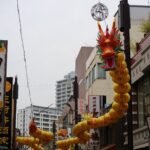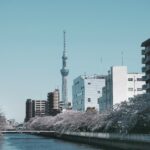Skip the usual tourist spots—discover most unique places in Tokyo, from secret shrines and quirky museums to vintage arcades, hidden alleys, and offbeat neighborhoods that showcase the city’s wild and wonderful side.
Table of Contents
1. Park Hanayashiki
![15 Most Unique Places in Tokyo You’ve Probably Never Heard Of [2025 Updated] 6 Parc Hanayashiki Tokyo](https://tokyocandies.com/wp-content/uploads/2023/07/asakusa-hanayashiki-april-2013-14.webp)
Hanayashiki Park , the oldest amusement park in the archipelago, is a must-see attraction for those traveling to the Japanese capital with their children.
Founded in 1853 in the heart of Asakusa then considered the city’s entertainment district, what was then a simple botanical garden was transformed into a park of ultra-modern attractions for the time.
Today, Hanayashiki has inevitably aged but has retained an old-fashioned charm. Ferris wheel, haunted house, pirate ship, rollercoaster, we find all the classics of fairgrounds and theme parks in exotic vintage and Japanese versions.
Address: 2-28-1 Asakusa, Taito, Tokyo 111-0032, Japan
2. Ghibli Museum
![15 Most Unique Places in Tokyo You’ve Probably Never Heard Of [2025 Updated] 7 Ghibli Museum Tokyo](https://tokyocandies.com/wp-content/uploads/2023/07/2021-02-21.jpg)
Created in 1985 by Hayao Miyazaki and Isao Takahata, Studio Ghibli has become known throughout the world for its very beautiful animated feature films. Far from the violence that many Japanese anime are criticized for, Miyazaki’s works depict touching stories of characters living in harmony with nature. From the legendary My Neighbor Totoro to Howl’s Moving Castle, Princess Monokéké, and Spirited Away, most of the films released by Studio Ghibli have enjoyed public and critical success far beyond the borders of the archipelago.
After being welcomed by a statue of Totoro, a key character in Miyazaki’s work, we find in the various rooms of the Ghibli Museum all the colorful and dreamlike universe of the works of Miyazaki and his companions through drawings, installations, and screenings. An enchanting visit that will delight children and parents and which will naturally end with a walk or picnic in the charming Inogashira Park , a very popular green space among Tokyo families.
3. Ueno Park
![15 Most Unique Places in Tokyo You’ve Probably Never Heard Of [2025 Updated] 8 Ueno Park In Tokyo](https://tokyocandies.com/wp-content/uploads/2023/07/Ueno-Park.jpg)
Ueno Park is a must-see in the city, especially if you are visiting the city with the family. With 140 hectares, this park is one of the lungs of the city and above all houses several cultural points of interest without equal in the city: three major museums are located there. The Tokyo National Museum, the National Museum of Nature and Science, the National Museum of Western Art, and the Tokyo Metropolitan Art Museum are close to the city’s Zoo, the oldest in the country, a myriad of historical temples ( Kaneiji and Kiyomizu Kannon to name only the best known), a vast lake and giant Buddha sculptures.
In early spring, the park is a favorite meeting place for many Tokyoites. Its many cherry trees, the famous sakura , make it one of the favorite spots to celebrate hanami in the company of locals.
Address: Ueno Park, 5-20 Taito, Tokyo 110-0007
4. Kagurazaka (District)
![15 Most Unique Places in Tokyo You’ve Probably Never Heard Of [2025 Updated] 9 Kagurazaka District In Tokyo](https://tokyocandies.com/wp-content/uploads/2023/07/9a98564b4430c9216ffe25ceefb5e754.jpg)
Fifteen minutes from Shinjuku to the east, and within walking distance of Tokyo Dome, Kagurazaka is a charming, picturesque district.
Many shops (bookstores, bakeries, pastry shops), wine bars, and French restaurants are concentrated in this small district far from the classic tourist circuits.
I recommend that you discover the district during a night walk. The quiet and exclusive atmosphere of the district seduces many Tokyoites who come to dine there or have a drink. Very beautiful traditional restaurants are established there and some bars in the districts are among the most romantic in the city.
5. Shimokitazawa (District)
![15 Most Unique Places in Tokyo You’ve Probably Never Heard Of [2025 Updated] 10 Shimokitazawa Tokyo](https://tokyocandies.com/wp-content/uploads/2023/07/53405425_2242412362696490_8817021006272004096_n-1024x1024.jpg)
Shimokitazawa is the name given to the area from the eponymous metro station on the Keiō Inokashira Line just minutes from the hustle and bustle of Shibuya.
Shimokitazawa has transformed into a bohemian place welcoming several alternative shops (thrift stores, bars, and restaurants) and artists’ studios, who appreciated the location’s low rents and relative proximity to the town center. The area is charming with its small European-style cafes and laid-back arty atmosphere.
Shimokitazawa is also an ideal base for those who wish to stay in an apartment rather than a hotel. Some good addresses are notably available on AirBnB.
6. Yokohama (outside of Tokyo)
![15 Most Unique Places in Tokyo You’ve Probably Never Heard Of [2025 Updated] 11 Yokohama](https://tokyocandies.com/wp-content/uploads/2023/07/yu-kato-4ZZLUEzJAsI-unsplash-1024x768.jpg)
Barely thirty kilometers from Tokyo, Yokohama is the most populous city in Greater Tokyo in terms of inhabitants, making it the second largest city in Japan with nearly 4 million inhabitants.
The former fishing village, which had barely 1,000 inhabitants in the middle of the 19th century, has transformed into one of the largest ports in the world and an ultra-dynamic and cosmopolitan city. If you stay long enough in Tokyo, Yokohama is a pleasant excursion: its beautiful waterfront in the Minato Mirai 21 district, the Cosmo World amusement park and its huge Ferris wheel, the tallest office tower and Japan Landmark Tower residential building, and the Chinatown district (the largest in the world) or the Ramen Museum which will delight lovers of Asian noodles.
7. Odaiba (District)
![15 Most Unique Places in Tokyo You’ve Probably Never Heard Of [2025 Updated] 12 Odaiba](https://tokyocandies.com/wp-content/uploads/2023/07/Minato-1024x640-1.jpg)
Shunned by tourists, the Odaiba district is an opportunity to see where and how Tokyoites have fun on weekends. This district exclusively dedicated to shopping and entertainment is located on the artificial island of the same name.
One of the highlights of a visit to Odaiba is arriving by the ultra-modern monorail (the Yurikamome ) which winds through the middle of the buildings. Automatic, it offers spectacular views of the neighborhood and the bay and gives the pleasant impression of being in a futuristic video game. It alone justifies the trip to Odaiba.
Once there, architecture enthusiasts will be amazed, as the area concentrates many notable works, but it is especially children and shopping enthusiasts who will enjoy this district that looks like a mini Las Vegas: decorated mall, Ferris wheel, gigantic Toyota and Panasonic showrooms, science museums, ramen theme park or Legoland are among the attractions that attract Japanese crowds every weekend.
8. Nakameguro (District)
![15 Most Unique Places in Tokyo You’ve Probably Never Heard Of [2025 Updated] 13 Nakameguro Tokyo](https://tokyocandies.com/wp-content/uploads/2023/07/IMG_2122-1280x600-1-1024x480.jpg)
To the southwest of the city, Nakameguro is one of the most pleasant areas of the city for hanami , a traditional Japanese celebration that consists of celebrating the blossoming of sakura, the famous cherry trees. From mid-March, their white and pink flowers appear for only a few days, symbolizing an ephemeral beauty that all the people of Japan hasten to celebrate by going to drink and eat under the cherry trees!
With its bucolic atmosphere and sakura–lined river, Nakameguro is a prime destination for hanami celebrations without leaving the heart of the city. And even without coming to celebrate the cherry trees, the area is very pleasant all year round. Cafés, restaurants, bookstores, and alternative shops abound in this small bohemian enclave.
9. Ikenoue (District)
![15 Most Unique Places in Tokyo You’ve Probably Never Heard Of [2025 Updated] 14 Ikenoue Tokyo](https://tokyocandies.com/wp-content/uploads/2023/07/ikenoue-underrated-tokyo.jpg)
Just three stations west of Shibuya (a few minutes on the Keiō Inokashira Line), Ikenoue is a pleasant residential area with beautiful traditional houses and perfectly trimmed trees. A wealthy middle class lives in this little piece of Tokyo that looks like a small provincial town and yet is so close to the ultra-center of the largest city in the world. The contrast is all the more striking when you arrive directly from the bustling Shibuya station, one of the largest urban train stations in the world.
While there is nothing spectacular in Ikenoue, you will immediately be seduced by the peaceful atmosphere that reigns here. Take the opportunity to have a coffee at the Kamakura Café or enjoy a French-style pastry at Pâtisserie Pierre, two spots particularly appreciated by locals. You can then continue on your way to the bohemian district of Shimokitazawa just a few minutes walk away.
10. Asagaya (District)
![15 Most Unique Places in Tokyo You’ve Probably Never Heard Of [2025 Updated] 15 Asagaya](https://tokyocandies.com/wp-content/uploads/2023/07/14146869896_05c566b706_k-1200x800-1-1024x683.jpg)
Jazz lovers will not miss Asagaya, a leafy town just 12 minutes by train from Shinjuku. Every year at the end of October, this little corner of Tokyo, which looks like a quiet residential suburb, hosts the Asagaya Jazz Streets festival for 2 days, which invades bars, restaurants, churches, schools, and temples. Jazz bands are everywhere distilling their swings to an audience from all over the city to take part in this popular and accessible event.
Many public places offer concerts for free.
11. Shoto (District)
![15 Most Unique Places in Tokyo You’ve Probably Never Heard Of [2025 Updated] 16 Shoto District In Tokyo](https://tokyocandies.com/wp-content/uploads/2023/07/2-1.jpg)
A stone’s throw from the famous Shibuya crossroads is a surprisingly peaceful district, a thousand miles from the hustle and bustle that reigns here: Shoto station.
To easily find your way, start from Don Quijote, the iconic store in Shibuya, take a left on Bunkamura-dori and after a few minutes walk you will reach Shoto. Nothing spectacular here but narrow streets giving the neighborhood a village feel filled with many bars and restaurants from around the world: French wine bars, Australian grill (Arossa), creperie (Galettoria), Hawaiian burgers ( Tomboy ), Mexican burritos (Junkadelic Jalopy). Foodies will be in heaven.
Finish your visit to the neighborhood with the tiny Shoto Park, a haven of peace.
12. Yanaka and Nezu (Districts)
![15 Most Unique Places in Tokyo You’ve Probably Never Heard Of [2025 Updated] 17 Yanaka and Nezu Districts In Tokyo](https://tokyocandies.com/wp-content/uploads/2023/07/Inari-at-Nezu-Shrine-1024x683.jpg)
Slightly removed from the center of town, Yanaka and Nezu (accessible via the well-connected Nippori Station) are two of the most picturesque historic neighborhoods in a city that has been largely rebuilt over the past fifty years. Few of the city’s suburbs have withstood the earthquakes, the bombings of war, and the real estate craze that gripped the Japanese capital in the 1980s when the bubble was in full swing. Yanaka and Nezu are among those.
Today, there is a quiet and arty atmosphere there, with galleries, cafes, and trendy stalls springing up alongside historic businesses (tatami and tofu manufacturers) in the traditional wooden houses that are the hallmark of the neighborhood.
Do not miss during your visit the peaceful and romantic atmosphere of the old Yanaka Cemetery , as well as the very peaceful Nezu Shrine.
13. Jindai Motomachi
![15 Most Unique Places in Tokyo You’ve Probably Never Heard Of [2025 Updated] 18 Jindai Shokubutsu Koen botanical garden In Tokyo](https://tokyocandies.com/wp-content/uploads/2023/07/jindai-bot-tulips.jpg)
Jindai Motomachi is a pleasant excursion for those who wish to discover the Japanese capital from another angle. About thirty kilometers west of the city (allow one hour by transport via the JR Chuo Line or the Keio Line), this small suburban town recalls the Edo period, the name once given to Tokyo.
The Jindai Shokubutsu Koen (botanical garden) with its well-trimmed trees and lush vegetation is a popular place for walks by Tokyoites, as are the few quiet streets around the park. Do not miss the Jindaiji , an 8th-century temple that is the second oldest in the country. The path leading there is filled with street vendors offering typically Japanese sweets.
End the day with a soba dish at Matsubajaya. The traditional and authentic atmosphere in this small wooden house is remarkable for the fireplace around which the guests gather. A real journey back in time far from the usual tourist trails.
14. Kawagoe (outside of Tokyo)
![15 Most Unique Places in Tokyo You’ve Probably Never Heard Of [2025 Updated] 19 Kawagoe](https://tokyocandies.com/wp-content/uploads/2023/07/2022-10-22.jpg)
Kawagoe is a town near Tokyo. Nicknamed “ little Edo” by the locals, Kawagoe is therefore a place of attraction for Tokyoites and Japanese who come to immerse themselves in the roots of their cities. Tourists are rare here, which adds to the charm of this small town which concentrates many houses dating from the 19th century on Ichiban-gai Street and its surroundings. Also, don’t miss the Kita-in Temple or the Toki no Kane Tower , two typical examples of period architecture.
15. Nikko (outside of Tokyo)
![15 Most Unique Places in Tokyo You’ve Probably Never Heard Of [2025 Updated] 20 Shrine In Nikko Japan](https://tokyocandies.com/wp-content/uploads/2023/07/98-6-1024x532.jpg)
Barely 2 hours from Tokyo (by train or by car), Nikkō is a favorite destination for Tokyoites who appreciate its bucolic atmosphere and come to recharge their batteries in the many onsen in the region.
What makes Nikkō a major tourist center in the country are its historic temples and shrines, all of which are listed as UNESCO World Heritage Sites. In total more than a hundred sacred places are spread over the 50 hectares of the park, which makes it with Kamakura and Nara one of the largest concentrations of period temples in the archipelago. The garden of cedars and pines is also absolutely remarkable, very representative of the sense of detail and the attachment that the Japanese have for aesthetics.
Take your time, enjoy the beauty of the place, and spend a night in a beautiful ryokan in the region. The experience will be much more pleasant.
- Top 14 Japanese Streetwear Brands That Are Redefining Cool Right Now (2025)

- 15 Tokyo Best Bars You’ll Love [2025 Guide]
![15 Tokyo Best Bars You’ll Love [2025 Guide] 2 Tokyo Best Bars](https://tokyocandies.com/wp-content/uploads/2023/08/image-15-150x150.jpg)
- 16 Best Anime and Manga Stores in Tokyo: Otaku Shopping Guide for Every Fan (2025)

- What to Do in Yokohama with kids: 20+ Must-See Spots & Experiences (2025)

- 10 Best Tokyo Tours You Absolutely Can’t Miss in 2025 (From Foodie Walks to Cultural Adventures)

